QM Solutions Need Quality Assurance, Too
Five testers are responsible for the qual- ity assurance of newly encoded items. They perform a test case based on the acceptance criteria. In these test cases, an exemplary application is carried out in accordance with a test description that is drafted prior to the test. During the test, the item must behave in exact accordance with the acceptance criteria. The test case is documented precisely; if there are any deviations, the item is returned to the developer. They are then required to resolve the deviations and to run through the code review pro- cess once more before handing the item to the software tester. As soon as the tester has approved the item, it is handed over to the responsible product manager. The product manager then inspects the item once more to ensure it corresponds with their ideas, which have been captured in writing. If the re- sults are positive, the item is approved and its sprint ends here.













Comments
No comments